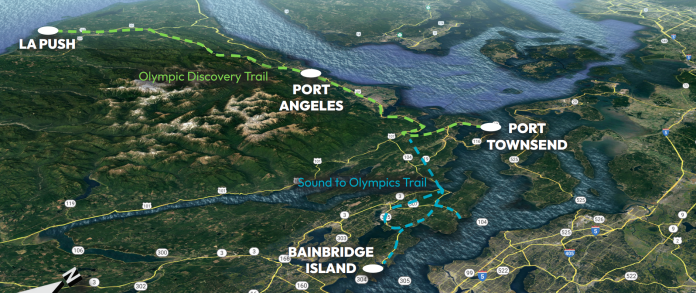
This week the U.S. Department of Transportation (USDOT) is set to award $16.1 million to advance planning and design work for multiple segments of multiuse trail on the Kitsap and Olympic peninsulas. The ultimate vision, being branded the Puget Sound to Pacific Trail, would connect over 200 miles from the Bainbridge Island ferry terminal all the way to La Push, Washington.
While no construction funding is included in this grant, the significant amount of federal dollars awarded here will advance a number of segments to full shovel-ready status, significantly accelerating their anticipated construction timelines. The award is part of the Rebuilding American Infrastructure with Sustainability and Equity (RAISE) program, and one of nine projects selected across Washington this year.
USDOT awarded the full dollar amount requested in the grant application, which was administered by the city of Port Angeles but included 12 other jurisdictions in the state including the Washington State Department of Transportation (WSDOT), Clallam, Kitsap, and Jefferson counties, the Port Gamble S’Klallam and Quileute Tribes, the Port of Port Townsend, and the cities of Bainbridge Island, Poulsbo, Sequim, Forks, and Port Townsend.
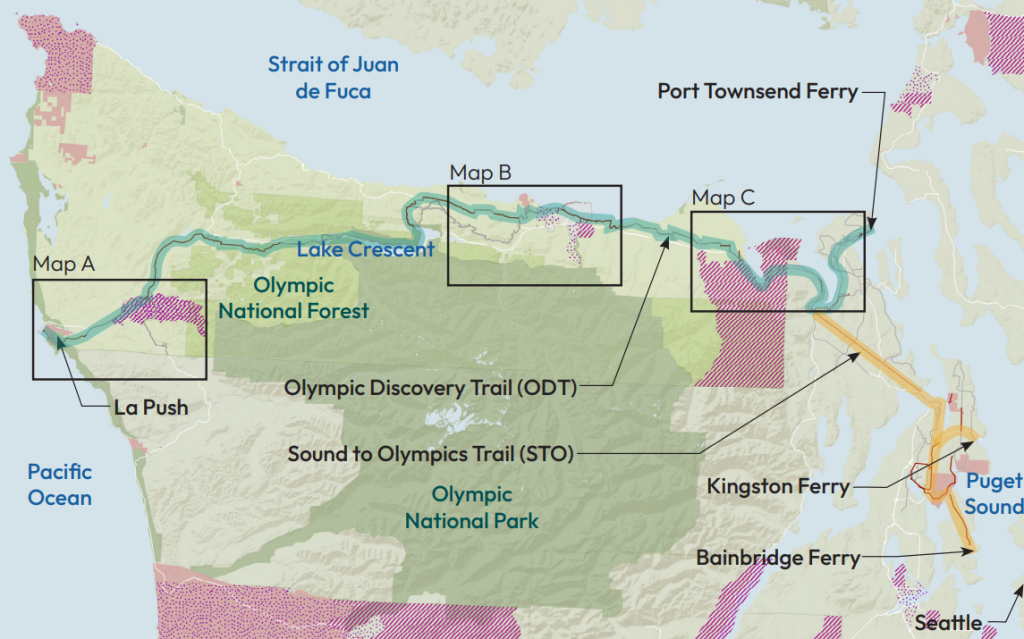
The Puget Sound to Pacific Trail builds on the existing 135-mile-long Olympic Discovery Trail between Port Townsend and La Push, and the driving organization behind its development for the past 35 years is the Peninsula Trails Coalition – a key advocate for the application of this grant. The ultimate vision of this new Puget Sound to Pacific Trail is a full connection between two multi-use trails, the Olympic Discovery Trail – which currently has segments totaling 90 miles of completed trail across the north Olympic Peninsula, and the Sound to Olympics Trail, which exists as two short segments of trail in Kitsap County.
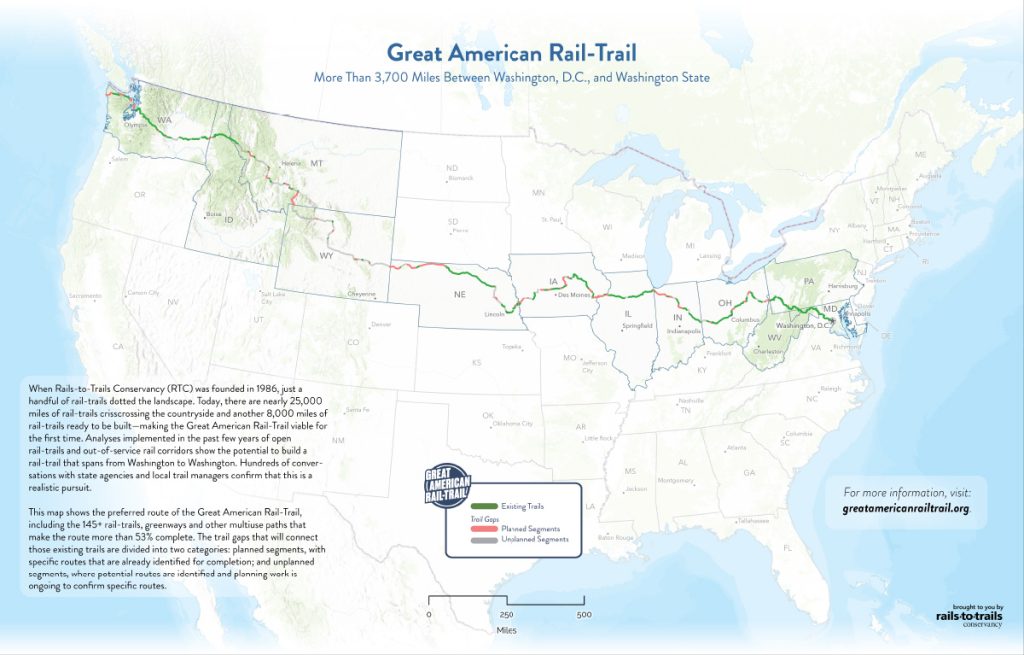
With an eastern terminus at the Winslow ferry terminal in Bainbridge Island, the trail will also have spurs to Port Townsend and Kingston. The section of the Puget Sound to Pacific trail in Kitsap County represents a portion of the 900 miles of trails across central Puget Sound envisioned by the Leafline Trails Coalition. It also constitutes the western end of another ambitious trail vision: the Great American Rail-Trail, which would reach 3,700 miles coast to coast from La Push to the other Washington on the East Coast when completed. Additional support for this effort to close the trail gaps has come from the Rails-to-Trails Conservancy, which has been assisting rail-trail projects and networks like this nationwide since 1986.
Governor Inslee biked a segment of the Olympic Discovery Trail earlier this month and was honored with an award for his trail expansion work at the Rail-to-Trails Conservancy’s annual summit held in Sequim this year.
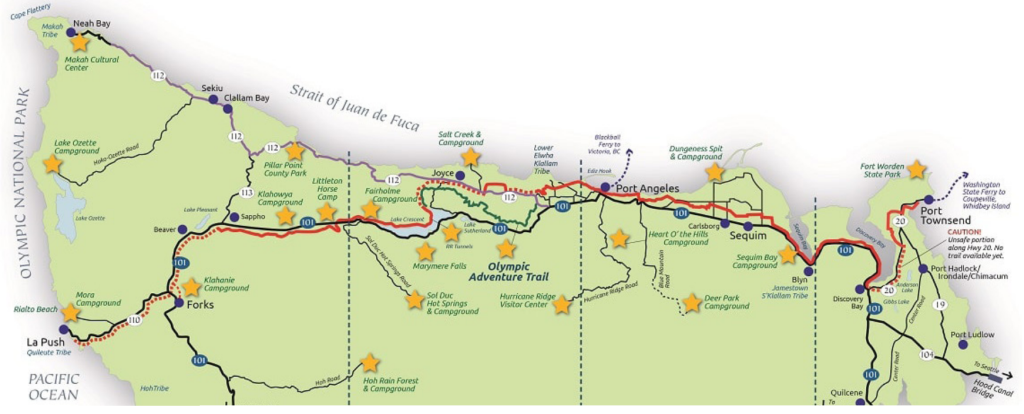
U.S. Senator Maria Cantwell, touting the award ahead of an official USDOT announcement later this week, noted the economic benefits of creating these new trail connections.
“Outdoor recreation contributes $20 billion to the state economy,” Cantwell said. “This grant will help complete the Great American Rail Trail in the State of Washington, generating an additional 240 jobs and resulting in an anticipated additional $25 million in tourist spending.”
Connecting three counties and numerous cities and tribal lands has the potential to make a significant impact on the state’s transportation system, connecting ferry terminals with job centers and going a long way toward creating bike superhighways that local cities can build upon for their local transportation networks.
In Port Angeles, $1 million of this grant will go toward designing improvements to the existing waterfront trail through the middle of the city, where the existing trail is little more than a sidewalk right now. Another $1.8 million will go toward designing ways to upgrade Race Street through Port Angeles to connect directly with the Visitor’s Center at Olympic National Park.
“The City of Port Angeles is honored to be the lead agency on this amazing collaboration, which will benefit the entire region and beyond. We look forward to working with our local and regional partners to complete this very important and exciting project,” Port Angeles Mayor Kate Dexter said following the announcement.
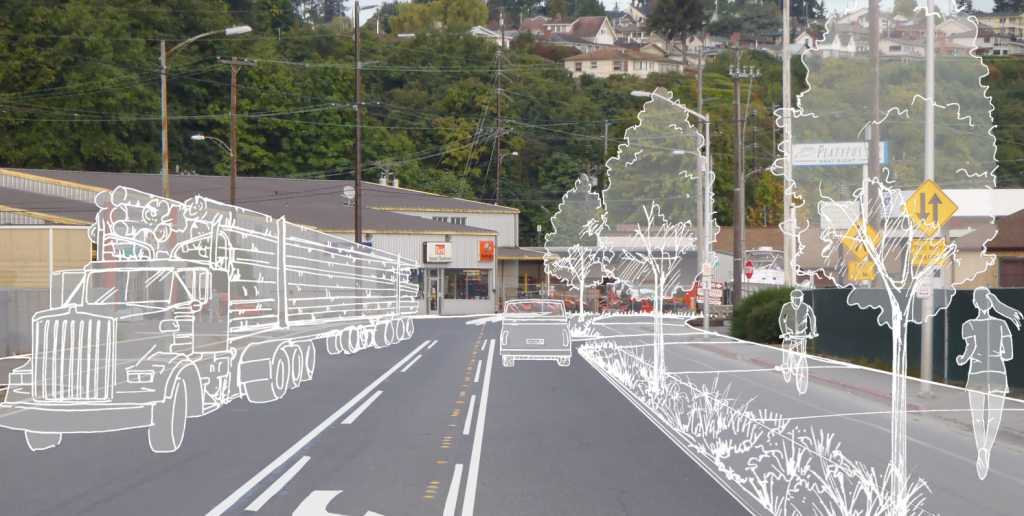
Representative Derek Kilmer, whose district encompasses the entire route of the planned trail, called the grant award “a big deal.”
“This investment in the Puget Sound to Pacific trail will help connect workers to jobs, local residents to essential services, and folks looking for recreation to some of our region’s natural treasures,” he said in a statement in advance of the award’s official announcement this week. “Having the federal government provide this grant funding means we will see improved trail connectivity and better safety without the cost being borne entirely b[y] taxpayers in our neck of the woods. That’s a huge win for our region.”
On Bainbridge Island, where the easternmost portion of trail planned will connect with the ferry terminal to Seattle, around two miles of trail will be funded to 100% design, with another 4.5 miles brought to 30% design. There the trail is largely planned to follow the path of State Route 305 up to the Agate Pass bridge. The Bainbridge Island Parks and Trails Foundation, one of the advocacy organizations behind the idea for a Puget Sound to Pacific Trail, calls its vision for this segment of trail a “regional trail, a neighborhood connector, and a linear park.” The Sound to Olympics trail is the backbone of the city’s Sustainable Transportation Plan, which the city council approved dedicated funding for last year.

“[The Puget Sound to Pacific Trail] will be the spine of an ‘active transportation’ corridor and greenway that shifts short commutes away from automobiles to human-scaled and people-powered travel modes like walking and bicycling. It aligns with transportation and climate goals and policies at every level of state and local government,” the Parks and Trails Foundation said Friday in a joint statement with the City of Bainbridge Island.
Getting so many of these trail segments significantly advanced in design will set local tribes, counties, and cities up to be able to request construction funding in future years, from federal sources like the RAISE program or from the increased amount of bike and pedestrian funding included in the state’s Move Ahead Washington transportation package. Receiving the full award from USDOT this year represents a significant achievement and makes the dream of a fully connected trail much closer to reality.
Ryan Packer has been writing for The Urbanist since 2015, and currently reports full-time as Contributing Editor. Their beats are transportation, land use, public space, traffic safety, and obscure community meetings. Packer has also reported for other regional outlets including BikePortland, Seattle Met, and PubliCola. They live in the Capitol Hill neighborhood of Seattle.

